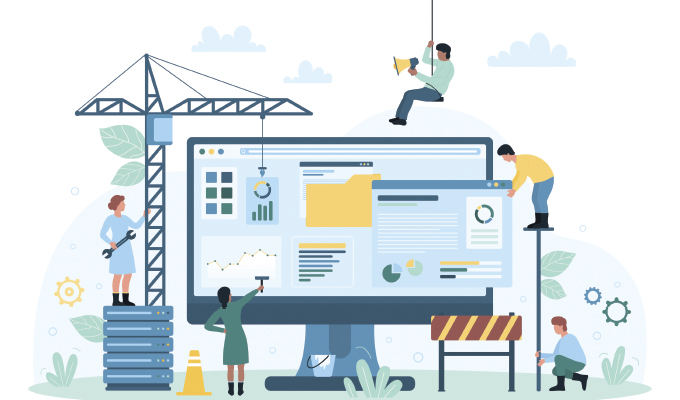Avid video game players often experiment with cheat codes, most of which you’ve probably heard of, even if you don’t play: godmode, unlimited ammo, warp to any level, etc. One of the coolest cheats is “no-clip” mode, which tells a video game not to enforce the boundaries within the environment (walls, floors, ceilings, etc.), allowing the player to walk through them at will. The player must still traverse the virtual distance to get to their goal in the game environment, but it’s a great way to zip past challenges by reducing barriers.
But this is Modern Construction Solutions, and construction administration isn’t a video game: What possible commonality is there between video game cheats and Requests-for-Information (RFI) / submittal workflows?
Using the right coordination platform can eliminate the barriers to progress that cause your RFIs and submittal workflows to slow down, effectively letting you “no-clip” your way past the tedious parts of those workflows.
TYPICAL RFI / SUBMITTAL WORKFLOW
Before we get into how a coordination platform reduces barriers in your contract administration, let’s first establish what most firms go through when using a Construction Project Management System (CPMS) for their RFI and submittal workflows.
A CPMS platform is software which serves as the central collaboration hub for owners, general contractors, specialty contractors, and other stakeholders across the entire project lifecycle. A CPMS like Procore, for example, lets GCs manage RFIs and submittals, and keeps its users updated on their progress as they go through the workflow.
Other stakeholder teams, such as the design team or project managers, may be using entirely different platforms, such as authoring or clash-detection tools. However, without a unifying Information Management platform, the follow-up is a nightmare and data can get lost as each team works in its own environment.
The RFI and submittal workflow is a long process without a unified Information Management platform, and it looks like this:
- The general contractor creates a submittal or RFI in the CPMS.
- The general contractor creates an email with all the information from the submittal or RFI and sends it to the design team.
- The design team creates an RFI or submittal in their system.
- The design team reviews the submittal or RFI using their own system.
- The design team submits an official response by email and attaches any relevant files.
- The general contractor then downloads their response, including any essential files, and saves it in the CPMS.
- The general contractor then reviews the design team’s answer. Should there be any additional queries from the general contractor, they can re-open the RFI or submittal and begin this process anew.
That’s a seven-step workflow! It depends on multiple specialists to weigh in, changes hands numerous times, and doesn’t even account for the time it takes to fill out the requisite forms. Typical projects have hundreds, if not thousands, of these to process.
Any delay for review and response can be costly, impacting deadlines, rework, and budgets. Among the most frequent culprits of the delays are the manual efforts to upload and download submittal and RFI information between construction management systems: typing out the requisite information, and the high number of clicks to attach relevant files and send them off.
ADDING A COORDINATION PLATFORM
Project Information Management platforms like Newforma Konekt provide a central location for all your project records. This streamlines communication between you and your stakeholders and increases efficiency in your project.
An effective coordination platform uses a tailored integration approach to work within your existing tech stack, so you don’t have to change or abandon the tools you like to use. As a master aggregator of the Architecture, Engineering, Construction & Operations (AECO) software ecosystem, Newforma Konekt integrates with your collaborator’s software even if it’s different from yours, to tie together all project information.
This eliminates data silos, makes working with other firms easier, and mitigates risks by connecting scattered project information into a secure, centralized system, ensuring that if the information exists, you can find it.
Newforma Konekt’s Procore Workflow Connector is an integration that allows Newforma Konekt’s Submittals and RFI features to automate and connect workflows, which significantly improve response times.
What does this mean for project managers? For starters, it lets you:
- Stay on top of overdue items and upcoming items, and track ball-in-court with the submittals and RFI dashboard.
- Keep all information required to respond to a submittal or RFI in one central place, including all email responses and project files.
- Avoid double data entry. Automatically transfer submittal and RFI information between connected Procore construction management applications.
- Optimize the management of your review process with consultants.
THE WORKFLOW CONNECTOR CHEAT CODE
By using a coordination platform that can connect with the leading CPMS to aid in its workflow, you can “no-clip” your way through barriers that slow down your RFI and submittals procedures. Remember that seven-step workflow?
Instead, this is what the process could look like:
- General contractor creates a submittal or RFI in CPMS, and the connector to the coordination platform automatically adds it as a pending RFI or submittal.
- The design team reviews the submittal or RFI in the coordination platform.
- The design team submits an official response with any relevant files; automatically transferring it to the CPMS.
- The general contractor then logs into Procore and reviews the design team’s answer.
Cutting these steps from seven to four saves lots of time and money.
About the Author:
Alessandro Masi is Marcom Content Creator at Newforma and spends his days interviewing industry experts who are passionate about fostering collaboration in the AECO sector. For more, visit www.newforma.com.
Modern Contractor Solutions, February 2024
Did you enjoy this article?
Subscribe to the FREE Digital Edition of Modern Contractor Solutions magazine.



